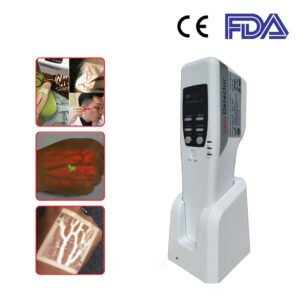Using Vein Finders with Phlebitis
Phlebitis means “inflammation of a vein”. The vein becomes inflamed because there’s blood clotting inside it or the vein walls are damaged. Superficial thrombophlebitis is the term for an inflamed vein near the surface of the skin (usually a varicose vein) caused by a blood clot.
Phlebitis may be caused by damage to the vein wall or by a blood clot that blocks a vein. Inflammation caused by a blood clot, or thrombus, is called thrombophlebitis. Blood clots can occur in veins near the surface of the skin or in veins deep within your muscles.
Phlebitis symptoms are often the following :
- leukemia and La
- Pain, swelling and tenderness of the skin, which, if on your leg, may get worse when you lower your leg.
- Red, itchy skin that feels warm to the touch.
- Low-grade fever if related to an infection.
Treatment seems unavoidable, but before it there should be an adequate and accurate diagnosis that perfectly locates the place of the veins to guarantee a quicker treatment.
The use of a vein finder would make it easier for the phlebotomist to locate the vein, lowering the likelihood of a pre-analytical error in the specimen collection and further aggravating the patient’s suffering.
Blood drawing might be challenging for the elderly due to their failing skin. Their skin thins, grows dryer, and becomes more fragile. Furthermore, as the blood vessels become more delicate, a venipuncture failure could easily cause these tiny blood vessels to burst. As a result, bruising, swelling, and even bleeding may occur beneath the skin, something Phlebitis patients mostly fear of.
The FDA Portable Vein Detector SIFVEIN-5.2 created by SIFSOF is designed for circumstances where locating a vein is difficult or necessitates extra concentration and care. Regardless of the patient’s age, skin color, or obesity level, the SIFVEIN-5.2 permits veins to be seen clearly in a depth of 10 mm beneath the skin.
It also has a depth recognition mode that improves judgment of the vein’s depth, as well as three colors (red, green, and white) that can be switched at any time based on the light in the room and the patient’s skin tone, making the vein more visible, easier to access, and increasing clinical accuracy. As a result, any potential failure diagnosis is ruled out, as well as the Phlebitis patient’s fear, tension, and pain.
Vein detectors, such as SIFSOF’s reliable and clear vein illuminator SIFVEIN-5.2, have so proven their effectiveness during this difficult IV procedure. That’s why it should be doctors’ nurses and Phlebitis patient’s first option if they are looking for an accurate diagnosis and effective treatment.
Reference: superficial thrombophlebitis
Disclaimer: Although the information we provide is used by different doctors and medical staff to perform their procedures and clinical applications, the information contained in this article is for consideration only. SIFSOF is not responsible neither for the misuse of the device nor for the wrong or random generalizability of the device in all clinical applications or procedures mentioned in our articles. Users must have the proper training and skills to perform the procedure with each vein finder device.
The products mentioned in this article are only for sale to medical staff (doctors, nurses, certified practitioners, etc.) or to private users assisted by or under the supervision of a medical professional.

